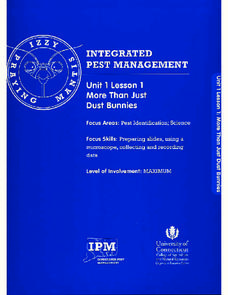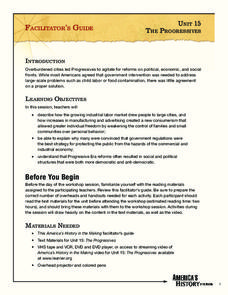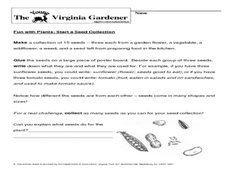EduGAINs
Consumerism, Me and the Natural Environment— Canadian and World Studies
Just as no man is an island, no country is totally independent of other countries. To understand the impact of individual consumer decisions on the global natural environment, class groups consider how the stuff they purchase connects to...
Achieve
Ivy Smith Grows Up
Babies grow at an incredible rate! Demonstrate how to model growth using a linear function. Learners build the function from two data points, and then use the function to make predictions.
It's About Time
How Atoms Interact with Each Other
Connect the dots and assist young chemists as they demonstrate covalent and ionic bonding. Class members use their knowledge of valence electrons to predict compound formulas as they arrange electrons into various bonding structures to...
University of Connecticut
More Than Just Dust Bunnies
Teenagers will never complain about cleaning their rooms after this activity. In the first lesson of a four-part series, budding scientists collect samples of dust, chalk, and other particulates from various areas of the classroom. They...
Rochester Institue of Technology
Meal Picking
Scholars explore systems design and its relation to meal picking by using computer simulations to test systems designs. They learn about the Pick-to-Light System and calculate average picking times.
Virginia Department of Education
Predator-Prey Simulation
Do your pupils have the misconception that environmental predators are "bad" and harm smaller creatures? The simulation explains, in detail, the important role predators play in maintaining a stable ecosystem. Through web-based research,...
K5 Learning
Moving On
Read about Daniel Boone and his early years in a new land in Yadkin County, North Carolina. After reading, pupils respond to four comprehension questions that address the how and the why.
Teaching History
Jamestown: The Starving Time
Students analyze a variety of primary and secondary sources to determine the cause of the Jamestown starving time during the winter of 1609–1610.
Cornell University
Discovering Enzymes
Explore the function of enzymes through a series of lab investigations. Learners use household enzymes such as hydrogen peroxide to model the role of enzymes. The enzymes break down proteins with and without a catalyst.
Colorado State University
Why Do Raindrops Sometimes Land Gently and Sometimes with a Splat?
A mouse can fall from large heights without injury! Air resistance is a large influence on small falling objects. In an exploratory lesson, young scholars build a raindrop bottle to compare the falling rate of different-sized objects.
Nuffield Foundation
Measuring Rate of Water Uptake by a Plant Shoot Using a Potometer
How quickly does a plant transpire? Learners explore this question through measuring water uptake with a potometer. They time the movement of a bubble a set distance to understand the motion and rate of speed.
Annenberg Foundation
The Progressives
The Progressive Era brought about a word that often leads to turmoil—change! Learners research the late 1800s in American history to uncover societal issues gripping the nation back in the day. The 15th lesson of a 22-part series...
Curated OER
What's On Your Plate?
Students explore the use of sensory details in writing. In this journal writing instructional activity, students write four journal entries after group discussion about a variety of topics such as their weekend, poverty in the United...
Curated OER
Making an Edible Coral Polyp
Students study anatomy. In this coral reef lesson, students recreate the anatomy of a coral polyp using edible materials. They work in pairs following step-by-step instructions given by the teacher. This lesson includes a list of...
Curated OER
$$$eaweed
Learners compare and evaluate the world's different seaweeds. In this investigative instructional activity students study seaweed and the harvesting of it. They then interpret the data collected and graph the seaweed production.
Curated OER
Choosing the Correct Adjective: Much or More
In this choosing the correct adjective: much or more worksheet, learners read explanations and examples of correct usage, then interactively complete 10 sentences, with immediate online feedback.
Curated OER
Shopping: a Pre-Intermediate Vocabulary Worksheet
In this shopping worksheet, students read about shopping words and store types, and complete a crossword puzzle. Students complete 13 spaces in the crossword puzzle.
Curated OER
Lesson 8: Chapter 6 (part 2) Life in the Great Ice Age
Young scholars read the assigned pages in a textbook and answer the associated questions. They write a paper based on the creationist view of origin of the Neanderthal man. They determine what is meant by a land bridge.
Curated OER
Beginning Spelling - In The Kitchen
In this spelling worksheet, students spell 12 kitchen words correctly using the definition that are listed to the right of the jumbled word.
Curated OER
Trust throughout the day
Pupils draw a picture of a world with and without trust. In this trust lesson plan, students discuss how trust plays a role in their lives every day and how the world would be if we couldn't trust each other.
Curated OER
Kitchen Safety
Learners examine rules and guidelines for Kitchen Safety by practicing them to prevent and maintain a safe working environment for themselves and others.
Curated OER
Place of Business- Intermediate ESL Matching
In this ESL vocabulary activity, students draw a line from the names of businesses to their descriptions. They make 11 matches that include businesses such as a store, a pharmacy, a mall, and a florist.
Curated OER
Health and Safety at Work
Students explore potential hazards of various work conditions. For this awareness lesson, students as a whole discuss health and safety issues on the jobsite, then complete a worksheet about the hazards of particular employees. The...
Curated OER
Start A Seed Collection
In this start a seed collection worksheet, students collect, label and display 15 seeds 3 each from a garden flower, a vegetable, a wildflower, a weed and the kitchen, and observe the differences.

























